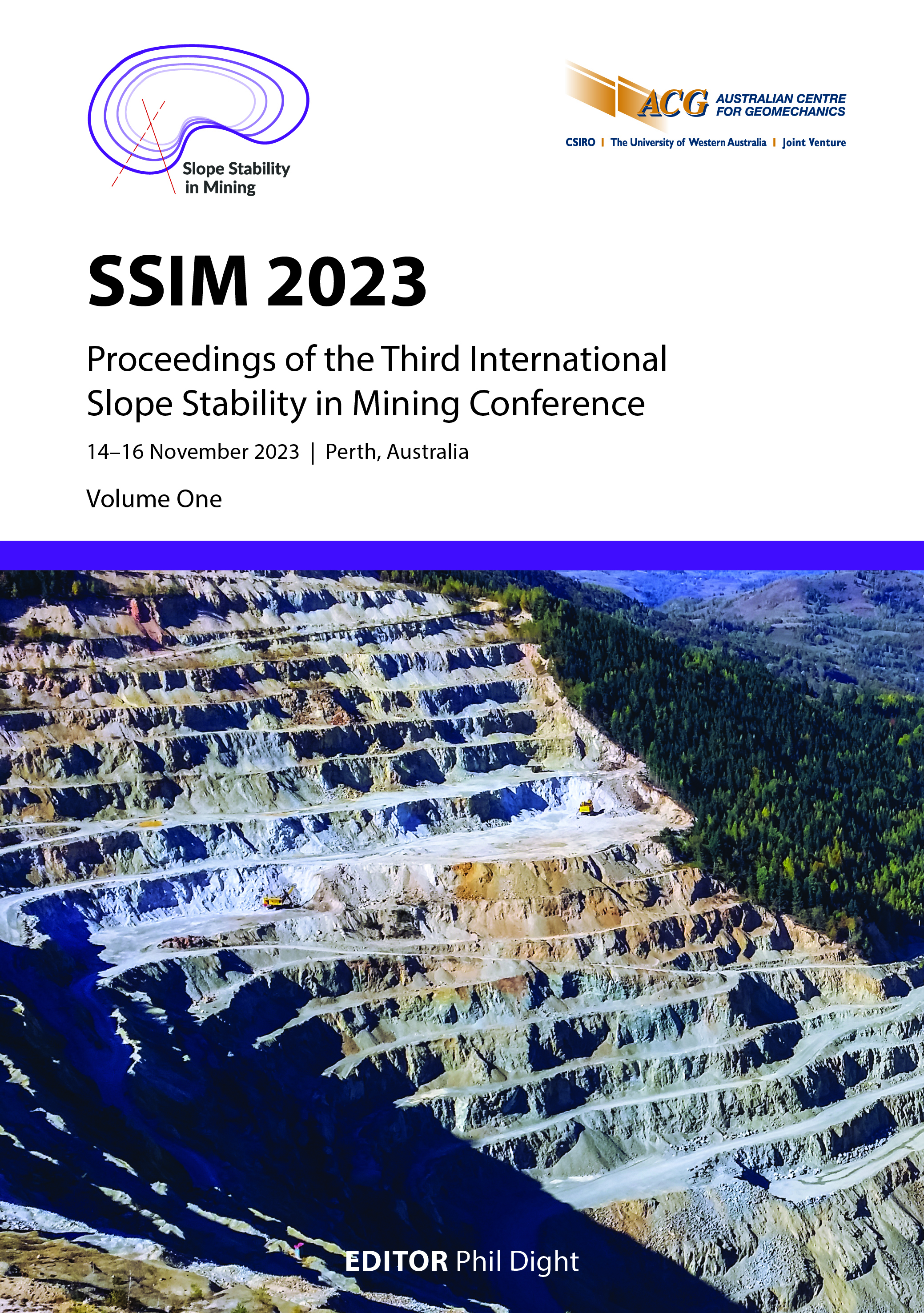Considerations for developing intact rock strength parameters for open pit applications

|
Authors: Condon, K; Martin, J; Valerio, M |
DOI https://doi.org/10.36487/ACG_repo/2335_22
Cite As:
Condon, K, Martin, J & Valerio, M 2023, 'Considerations for developing intact rock strength parameters for open pit applications', in PM Dight (ed.), SSIM 2023: Third International Slope Stability in Mining Conference, Australian Centre for Geomechanics, Perth, pp. 373-386, https://doi.org/10.36487/ACG_repo/2335_22
Abstract:
Intact rock strength is a fundamental parameter used in rock mass characterisation for open pit slope design. Obtaining reliable intact strength parameters is dependent on the quality of data collected, characterisation of the failure behaviour considered and implementation of appropriate strength criteria. The strength results from laboratory testing can vary significantly due to natural sources of variability (e.g. lithology, defects, alteration), variability introduced through specimen preparation and testing techniques, and variability resulting from the failure behaviour exhibited by tested specimens. Laboratory strength testing must be performed to an industry standard to mitigate laboratory-induced sources of variability. Natural variability is captured through development of geotechnical domains based on rock mass characteristics. Laboratory specimen failure behaviour can be captured through the characterisation of failure modes (e.g. specimen rupture through shearing, axial splitting, spalling etc.) and failure types (e.g. failure though homogeneous rock matrix, along defects or through a combination of both). Classification of these failure behaviours aids in filtering out invalid test results and non-applicable failure behaviours that can introduce additional strength variability and impact design parameters. In heterogeneous rocks comprising healed discontinuities such as veins, the impact of these features on strength can be investigated through failure type classification. Consideration of the failure behaviour exhibited by laboratory specimens can aid in explaining strength variability and yield higher confidence in the parameters selected for design. The Hoek–Brown failure criterion is typically used to estimate the intact strength of hard rock by fitting a strength envelope to laboratory testing data. Variability among laboratory testing results can make it difficult to obtain reliable strength parameters even when failure behaviour, induced variability and natural variability are accounted for. Additionally, the approach used to fit the Hoek–Brown envelope to a dataset can result in different intact strength parameters depending on the selected optimisation algorithm and treatment of residuals. Thus it is often desirable to estimate a range of likely parameters and incorporate these ranges as sensitivities in modelling. Discussed in this paper are considerations for estimating intact strength parameters using the Hoek–Brown criterion for open pit applications.
Keywords: intact rock strength, pit slope design, Hoek–Brown criterion, failure behaviour, failure type, core damage
References:
ASTM International 2014, Standard Test Methods for Compressive Strength and Elastic Moduli of Intact Rock Core Specimens Under Varying States of Stress and Temperatures (ASTM D7012-14), ASTM International, West Conshohocken.
Bewick, R 2021, ‘The strength of massive to moderately jointed rock and its application to cave mining’, Rock Mechanics and Rock Engineering, vol. 54, no. 8, pp. 3629–3661,
Bewick, R, Kaiser, P & Amann, F 2019, ‘Strength of massive to moderately jointed hard rock masses’, Journal of Rock Mechanics and Geotechnical Engineering, vol. 11, no. 3, pp. 562–575,
Bewick, R, Ouellet, A, Otto, S & Gaudreau, D 2017, ‘Importance of understanding laboratory strength and modulus testing data for deep mining in hard brittle rocks’, in J Wesseloo (ed.), Deep Mining 2017: Eighth International Conference on Deep and High Stress Mining, Australian Centre for Geomechanics, Perth, pp. 827–842,
Bewick, RP, Amann, F, Kaiser, PK & Martin, CD 2015, ‘Interpretation of UCS test results for engineering design’, Proceedings of the 13th ISRM International Congress of Rock Mechanics, Montreal,
Ghazvinian, E, Diederichs, M, Martin, D, Christiansson, R, Hakala, M, Gorski, B, … Jacobsson, L 2012, Prediction Thresholds for Crack Initiation and Propagation in Crystalline Rocks, ISRM Commission on Spall Prediction.
Goodman, R 1989, Introduction to Rock Mechanics, 2nd edn, John Wiley & Sons, Hoboken.
Hoek, E & Brown, ET 2019, ‘The Hoek–Brown failure criterion and GSI - 2018 edition’, Journal of Rock Mechanics and Geotechnical Engineering, vol. 11, no. 3, pp. 445–463,
Hoek, E, Carranza-Torres, C & Corkum, B 2002, ‘Hoek–Brown failure criterion - 2002 edition’, in Proceedings of the NARMS-TAC Conference, Toronto, pp. 267–273.
Hoek, E & Brown, E.T. 1980, Underground Excavations in Rock, The Institution of Mining and Metallurgy, London.
ISRM 1981, Rock Characterization, Testing and Monitoring – ISRM Suggested Methods, ET Brown (ed.), Pergamon Press, Oxford.
ISRM 1978, ‘Suggested methods for determining the strength of rock materials in triaxial compression’, International Journal of Rock Mechanics and Mining Sciences & Geomechanics Abstracts, vol. 15, pp. 47–51.
ISRM 1979, ‘Suggested methods for determining the uniaxial compressive strength and deformability of rock materials’, International Journal of Rock Mechanics and Mining Sciences & Geomechanics Abstracts, vol. 16, no. 2, pp. 137–140.
Perras, M & Diederichs, M 2014, ‘A review of the tensile strength of rock: concepts and testing’, Geotechnical and Geological Engineering, vol. 32, no. 2, pp. 525–546,
Rocscience 2022, RSData, computer software, Rocscience, Toronto, https://www.rocscience.com/software/rsdata
Szwedzicki, T 2007, ‘A hypothesis on modes of failure of rock samples tested in uniaxial compression’, Rock Mechanics and Rock Engineering, vol. 40, pp. 97–104,
© Copyright 2025, Australian Centre for Geomechanics (ACG), The University of Western Australia. All rights reserved.
View copyright/legal information
Please direct any queries or error reports to repository-acg@uwa.edu.au
View copyright/legal information
Please direct any queries or error reports to repository-acg@uwa.edu.au

